Why was the “Kotya” tomato recognized as the best hybrid of the year?
Every year, tomato exhibitions are held in our country. On them, experienced gardeners present the fruits of their labors - beautiful and high-yielding tomato bushes. Participants in such events and their spectators choose leaders among the many varieties of this crop.
In 2018, domestic gardeners paid attention to the Kotya tomato from the Partner company. The exhibition featured hefty bunches with lots of yellow berries. They brought the hybrid popularity. How true are the reviews about this vegetable and how to get the maximum amount of fruits during the season - read on.
General description of the hybrid
Kotya is a first generation tomato hybrid. He was bred by the Russian breeder Nikolai Petrovich Fursov. Koti seeds are produced by the agricultural company "Partner".
The main distinguishing feature of Koti is its unusual egg-shaped fruits, yellow with orange streaks. The berries are small in size, each weighing no more than 45 g. Look how they look in the photo.
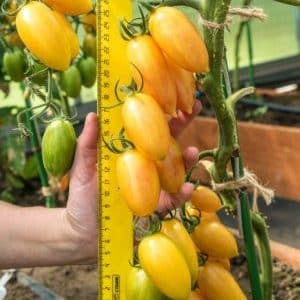 Tomatoes are formed in long clusters. Each of them contains up to 16 fruits. Because of this, tall bushes look very decorative.
Tomatoes are formed in long clusters. Each of them contains up to 16 fruits. Because of this, tall bushes look very decorative.
The taste of the fruit is also unusual - rich, sweet, with a slight sourness and a fruity aftertaste.
Yellow tomatoes are the most beneficial for health due to their high content of beta-carotene, which improves visual acuity, strengthens the immune system and speeds up metabolism. Yellow berries also contain a lot of lycopene, a strong antioxidant.
Yellow-fruited tomatoes are not only healthy, but also safe.They do not cause allergies, so they are suitable for small children and people prone to allergic reactions. Scientists note a reduced content of purines in such fruits.
Kotya tomatoes are mainly consumed fresh. They are suitable for preservation either whole or in puree form. During heat treatment, the usefulness of yellow-fruited tomatoes is reduced, since most of the vitamins are destroyed.
Characteristics
The Kotya tomato is easy to grow in our country, even in areas with unfavorable climatic conditions.
Let's look at the characteristics table:
| Parameter | Indicators |
| Bush type | Indeterminate hybrid. It reaches a height of 2 m. The bushes are sparsely leafy and form a small number of stepsons. The stems are strong, but not very thick. The leaves are small, light green, corrugated, with pronounced dissections along the edge. The first inflorescence is formed in the axil of 6-7 leaves, the next ones - every 1-2 leaves. The fruits are tied in clusters, 8–16 pcs. on each one. |
| Growing method | Tomato has increased resistance to cold weather. It is able to grow and produce high yields at the minimum permissible temperatures (15 degrees). It is grown both in a greenhouse and in open ground, but in the first case the yield indicators are higher. |
| Productivity | High. From 1 sq. m harvest up to 17 kg of berries. Fruiting is consistent and continues until cold weather. |
| Fruit | Small ones. The weight of one varies between 30–45 g. The color of the skin is bright yellow with dark orange and pink stripes. The inside is yellow with pink areas, without light and green spots in the center and at the base. The shape is ovoid, leveled, with a pointed nose and without ribbing at the base. The taste is sweet with a slight sourness. There is a lot of pulp, but it is juicy.Inside each berry there are 1-2 seed chambers. |
| Transportability | High. The thin but durable skin protects the fruits during transportation and allows them to be stored for up to 1 month. |
| Ripening time | Mid-early variety. The first fruits will ripen 95–110 days after sowing the seeds. |
| Disease resistance | It is immune to bacterial and brown spot, fusarium and tobacco mosaic virus. |
Pros and cons of a hybrid
Despite the fact that the hybrid is relatively young, it has already gained popularity among gardeners.
Advantages of Koti: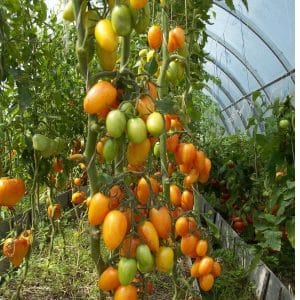
- cold resistance;
- unusual appearance of the fruit;
- high productivity;
- good taste;
- versatility of use;
- decorative appearance;
- resistance to tomato diseases;
- unity of maturation.
The disadvantages include the need for pinching and gartering of bushes.
Features of agricultural technology
Kotya is grown by seedlings. The time for sowing seeds depends on the region in which the tomato is planned to be cultivated:
- southern strip - late April or early May;
- central regions – second half of March;
- areas with a northern climate - early April.
The seedlings are planted in a permanent place when the soil temperature at a depth of 15 cm reaches 15-16 degrees. By this time, the plants should be 50–60 days old. When grown in a greenhouse, seeds are sown 2 weeks earlier.
Advice. It is important not to overexpose seedlings in pots. Otherwise, the plants will not take root well in their permanent location.
Preparing and sowing seeds
Before you start sowing, the seeds need to be prepared. Processing of planting material consists of three stages:
- Germination test. The seeds are soaked for half an hour in a solution prepared from 1 glass of water and 1 tsp. salt.The floating specimens are removed, and those that have sunk to the bottom are washed and used for planting.
- Etching. The seeds are soaked for 30 minutes. in a light pink solution of potassium permanganate, for 15 minutes. in hydrogen peroxide or for 12 hours in a solution of soda (1 teaspoon per 1 liter of water). After this they are washed.
- Stimulation of growth. Planting material is soaked in nutrient solutions. Of the purchased products, Epin is usually used. They can also be prepared at home, for example, by mixing the juice of three-year-old aloe leaves and water in equal proportions.
You also need to be responsible when choosing soil for seedlings. It should be light but nutritious. Those who do not want to buy a ready-made universal mixture mix equal amounts of sand, black soil and humus.
The soil and containers for tomatoes are pre-disinfected - treated with a dark pink solution of potassium permanganate.
Tomato seeds are sown in seedling boxes. They are placed in grooves 1 cm deep at a distance of 2 cm from each other, sprinkled with soil and watered with warm water from a spray bottle.
Containers with planting material are covered with glass or film and placed in a warm place, for example, near a heating radiator. Moisten the soil as it dries.
Seedling care
Growing seedlings yourself is not difficult. The main thing is to properly care for the plants:
- Watering. The soil is moistened as it dries with warm, settled water. The liquid should not get on the green tomatoes. It is important to ensure that the plants do not dry out, but water stagnation should not be allowed. Both negative factors contribute to root rot, the development of blackleg and the appearance of mold on the soil.
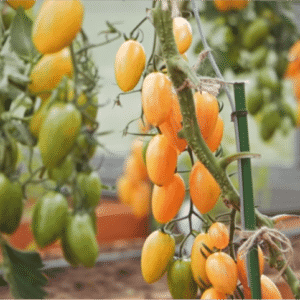
- After the first shoots appear, the film is removed. The seedlings are moved to a well-lit place.To prevent tomatoes from stretching, use fluorescent lamps.
- It is important that fragile the tomatoes were not exposed to a draft, which often becomes the cause of their illness and death.
- Tomatoes dive after the appearance of the first true leaves. A drainage layer is poured onto the bottom of the containers into which they will be transplanted. There is no need to pinch the central root of the plant; this will slow down the development of the seedlings.
- 2 weeks after picking, the tomatoes are watered and fed for the first time. The next 2 times, fertilizers are applied with an interval of 2 weeks. Use complex compounds with phosphorus.
- 2 weeks before planting in a permanent place, the plants begin to harden. This procedure allows the seedlings to quickly adapt to new conditions after transplantation. To harden, tomatoes are taken outside every day, gradually increasing the time.
Planting tomatoes in open ground
The beds for tomatoes are prepared in advance. In the fall, they are dug up and cleared of the remains of weeds and cultivated plants. Then for every 1 sq. m add 6 kg of humus. The soil is mixed with fertilizer. If necessary, acidity is reduced with dry lime.
Advice. To make the soil more fertile, rye is sown in the tomato beds in the fall. In the spring, when it sprouts, the seedlings are dug up so that all the greenery is underground. Then water it with Baikal diluted according to the instructions and cover it with film. In 2 weeks the rye rots.
It is important to choose the right site for growing tomatoes. Nightshade crops are the most undesirable predecessors. The place should be well lit, since the tomato is a light-loving plant.
In spring, the rows are leveled with a rake and cleared of weeds. Then pour in copper sulfate.
The holes are dug in rows in a checkerboard pattern.A 70×40 pattern is used. At 1st century m plant up to 4 plants.
Ash or fertilizer is poured into each recess. Then the plant removed from the pot is placed there along with a lump of earth. The holes are filled and watered. For each tomato use 1 liter of water.
Next time the tomatoes are watered after 2 weeks. At first, seedlings planted in open ground are covered with film at night to protect them from frost.
Rules for caring for adult plants
How high the Kochi harvest will be depends on how correct and regular its care is.
The list contains basic rules and advice from experienced gardeners:
- Form a tomato into 1 or 2 stems. In the first case, the tomatoes will ripen faster, and in the second, the harvest will be higher.
- During stepsons remove leaves below the first flower cluster and withered greenery. One such procedure is carried out per week, during which no more than three leaves are cut. On the day of planting, the plants are not watered.
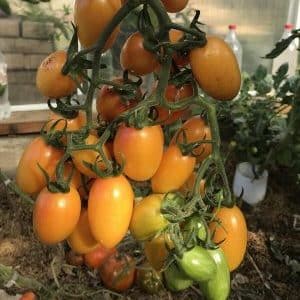
- Watered tomatoes as the soil dries out. This is done when the sun is not active. Use warm, settled water. The liquid should not fall on the above-ground part of the plant - this will increase the likelihood of burns on the leaves. The frequency of watering depends on the outside temperature. In the greenhouse, the soil is moistened only once a week.
- After each watering, the beds are loosened to remove the earthen crust, which impairs root air exchange. During the loosening process, they are cleared of weeds.
- During flowering, tomato bushes are periodically shaken, helping them pollinate. It is especially important to do this in a greenhouse.
- Tie up Kochi bushes are a must. Long, heavy brushes are also attached to the support.
- Kotya tomatoes are fed 2–4 times per season, alternating mineral and organic fertilizers.Another option: before planting, pour ash, eggshells, double superphosphate and compost into the holes for tomatoes, pour everything with a light pink solution of potassium permanganate and mix. In this case, you will have to feed the tomatoes only once per season with an infusion of nettle, ash and chicken manure diluted 1:10 with warm water.
Prevention of diseases and pests
Hybrid Kotya has high immunity to major tomato diseases. Despite this, it is important to follow the rules of prevention when growing:
- Disinfection. Disinfecting compounds are used to treat soil, seedling containers, seeds, greenhouse walls and garden tools.
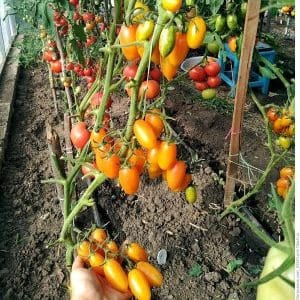
- Removing weeds. Weeds attract pests and transmit pathogens. This also applies to the remains of last year’s cultivated plants.
- Maintaining crop rotation. Tomatoes are not planted in beds where other nightshade crops grew the year before. In this case, the risk of tomato infection increases. Potatoes, which attract pests, should not be placed next to tomatoes.
- Compliance with watering rules. Both overdried soil and stagnant water serve as ideal conditions for the development of viral and fungal infections.
- Stepsoning. If you incorrectly break off part of the bush or water the plant on the day of this procedure, the risk of infection will increase.
- Pest protection. When growing small quantities of tomatoes, it is recommended to use safe homemade products. The bushes are sprayed with a solution of a piece of laundry soap and a bucket of water or a decoction of wormwood. Colorado potato beetles and slugs are collected by hand.
- To prevent late blight, hang an open bottle of iodine in the greenhouse. In unprotected soil, bushes are sprayed with copper sulfate or a light pink solution of potassium permanganate.
Reviews from gardeners
Reviews about Kota are mostly positive. Everyone who grew it notes that it is a beautiful, tasty and high-yielding tomato.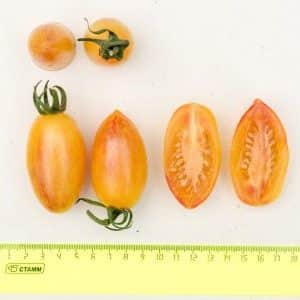
Irina, Krasnodar: “I tried to grow kittens from Partner in open ground and in a greenhouse. I liked the second option better, since the brushes were longer. Formed plants into one stem. I fed it with homemade fertilizers and superphosphate. The yield is high, as stated in the description of the variety, and the bushes and fruits are very beautiful. The largest clusters produced 16 berries and weighed 600 g.”
Vladimir. Samara: “After reading good reviews, I tried to raise Kotya in a greenhouse. I liked the tomato: it didn’t get sick, didn’t produce many shoots, and gave a lot of yield. Ripening is smooth, yellow striped fruits can be collected in clusters. The only thing is that I didn’t see any difference between Kotya and Shy Blush. By the way, seeds from Kochi berries produced exactly the same fruits, so I doubt its hybridity.”
Conclusion
If you are looking for an original tomato with high yields, pay attention to the Kotya hybrid. It has captivated many gardeners with its unusual egg-shaped fruits with orange and pink streaks.
Growing these tomatoes is not difficult. They are not afraid of tomato diseases and are characterized by increased cold resistance. Kotya is a godsend for both experienced and novice gardeners.